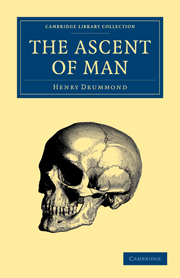Book contents
- Frontmatter
- Preface
- Contents
- THE ASCENT OF MAN
- INTRODUCTION
- CHAPTER I THE ASCENT OF THE BODY
- CHAPTER II THE SCAFFOLDING LEFT IN THE BODY
- CHAPTER III THE ARREST OF THE BODY
- CHAPTER IV THE DAWN OF MIND
- CHAPTER V THE EVOLUTION OF LANGUAGE
- CHAPTER VI THE STRUGGLE FOR LIFE
- CHAPTER VII THE STRUGGLE FOR THE LIFE OF OTHERS
- CHAPTER VIII THE EVOLUTION OF A MOTHER
- CHAPTER IX THE EVOLUTION OF A FATHER
- CHAPTER X INVOLUTION
CHAPTER II - THE SCAFFOLDING LEFT IN THE BODY
Published online by Cambridge University Press: 05 October 2010
- Frontmatter
- Preface
- Contents
- THE ASCENT OF MAN
- INTRODUCTION
- CHAPTER I THE ASCENT OF THE BODY
- CHAPTER II THE SCAFFOLDING LEFT IN THE BODY
- CHAPTER III THE ARREST OF THE BODY
- CHAPTER IV THE DAWN OF MIND
- CHAPTER V THE EVOLUTION OF LANGUAGE
- CHAPTER VI THE STRUGGLE FOR LIFE
- CHAPTER VII THE STRUGGLE FOR THE LIFE OF OTHERS
- CHAPTER VIII THE EVOLUTION OF A MOTHER
- CHAPTER IX THE EVOLUTION OF A FATHER
- CHAPTER X INVOLUTION
Summary
The spectacle which we have just witnessed is invisible, and therefore more or less unimpressive, except to the man of science. Embryology works in the dark. Requiring not only the microscope, but the comparative knowledge of intricate and inaccessible forms of life, its all but final contribution to the theory of Evolution carries no adequate conviction to the general mind. We must therefore follow the fortunes of the Body further into the open day. If the Embryo in every changing feature of its growth contains some reminiscence of an animal ancestry, the succeeding stages of its development may be trusted to carry on the proof. And though here the evidence is neither so beautiful nor so exact, we shall find that there is in the adult frame, and even in the very life and movement of the new born babe, a continuous witness to the ancient animal strain.
We are met, unfortunately, at the outset by one of those curious obstacles to inquiry which have so often barred the way of truth and turned discovery into ridicule. It happens that the class of animals in which Science, in the very nature of the case, is compelled to look for the closest affinities to human beings is that of the Apes. This simple circumstance has told almost fatally against the wide acceptance of the theory of Descent.
- Type
- Chapter
- Information
- The Ascent of Man , pp. 98 - 125Publisher: Cambridge University PressPrint publication year: 2009First published in: 1894



